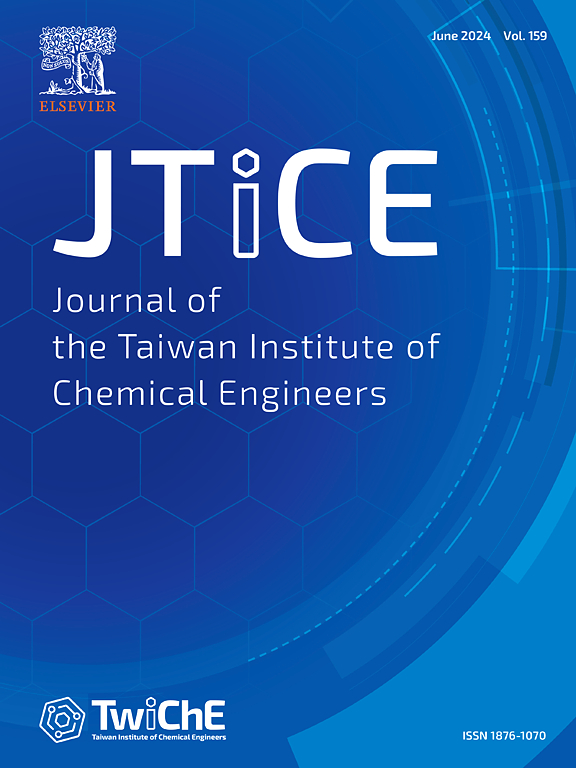通过设计氮化碳基同质结光催化剂来提高H2O2生成和木质素CC键裂解的光催化性能
IF 5.5
3区 工程技术
Q1 ENGINEERING, CHEMICAL
Journal of the Taiwan Institute of Chemical Engineers
Pub Date : 2025-07-10
DOI:10.1016/j.jtice.2025.106286
引用次数: 0
摘要
过氧化氢(H2O2)是纸浆工业中常用的氧化剂。与传统的蒽醌技术相比,光催化生产H2O2是一种绿色、可持续的方法。但光催化产H2O2的效率限制了其发展。同时,木质素经常作为废物排放,不仅污染环境,而且浪费资源。光催化裂解木质素CC键是利用木质素的有效方法。然而,木质素CC键的裂解效率是一个亟待解决的问题。提高上述两种反应的光催化效率,促进木质素在纸浆工业中的增值利用至关重要。方法采用竞争性自组装方法成功合成了一系列氮化碳同质结光催化剂SCN/CCN-X。一些表征技术和光电分析揭示了所制备光催化剂的元素组成、微观结构和光电性能。实验结果表明,SCN/CCN-1.5光催化剂对H2O2的生成和木质素CC键的裂解具有最佳的光催化性能。SCN/CCN-1.5具有最高的光生载流子分离效率和合适的氧化还原电位。此外,木质素CC键的裂解和光催化生成H2O2具有显著的协同效应。将木质素型1,2 -二苯乙醇加入到水与乙腈(15:5 v/v)的溶剂混合物中,光催化H2O2产率提高了13.1倍。机理研究表明,光催化生产H2O2遵循间接反应机理。光催化木质素CC键裂解符合Cβ自由基机制。H2O2光催化分解产生的羟基自由基促进木质素CC键的断裂。本文章由计算机程序翻译,如有差异,请以英文原文为准。

Enhancing photocatalytic performance for H2O2 production and lignin CC bond cleavage via designing carbon nitride-based homojunction photocatalysts
Background
Hydrogen peroxide (H2O2) is a commonly used oxidant in the pulp industry. Compared with traditional anthraquinone technology, photocatalytic H2O2 production is a green and sustainable approach. However, the efficiency of photocatalytic H2O2 production restricts its development. Meanwhile, lignin is often emitted as waste, which not only pollutes the environment but also wastes resources. Photocatalytic cleavage of lignin C![]() C bonds is an effective method to utilize lignin. However, the efficiency of lignin C
C bonds is an effective method to utilize lignin. However, the efficiency of lignin C![]() C bond cleavage is an urgent problem to be solved. It is essential to improve the photocatalytic efficiency of the above two reactions to promote the value-added utilization of lignin in the pulp industry.
C bond cleavage is an urgent problem to be solved. It is essential to improve the photocatalytic efficiency of the above two reactions to promote the value-added utilization of lignin in the pulp industry.
Methods
A series of carbon nitride homojunction photocatalysts SCN/CCN-X have been successfully synthesized through a competitive self-assembly strategy. Some characterization techniques and photoelectric analysis revealed the elemental composition, microstructure, and photoelectric properties of the prepared photocatalyst.
Significant Findings
The experimental findings revealed that the SCN/CCN-1.5 photocatalyst has the best photocatalytic performance for H2O2 production and lignin C![]() C bond cleavage. SCN/CCN-1.5 offers the greatest photogenerated carrier separation efficiency and appropriate redox potential. Moreover, lignin C
C bond cleavage. SCN/CCN-1.5 offers the greatest photogenerated carrier separation efficiency and appropriate redox potential. Moreover, lignin C![]() C bond cleavage and photocatalytic H2O2 production have a significant synergistic effect. When the lignin model 1, 2-diphenylethanol was added to a solvent mixture composed of water and acetonitrile (15:5 v/v), the photocatalytic H2O2 production rate increased by 13.1 times. Mechanistic studies have shown that photocatalytic H2O2 production follows an indirect reaction mechanism. Photocatalytic lignin C
C bond cleavage and photocatalytic H2O2 production have a significant synergistic effect. When the lignin model 1, 2-diphenylethanol was added to a solvent mixture composed of water and acetonitrile (15:5 v/v), the photocatalytic H2O2 production rate increased by 13.1 times. Mechanistic studies have shown that photocatalytic H2O2 production follows an indirect reaction mechanism. Photocatalytic lignin C![]() C bond cleavage conforms to the Cβ radical mechanism. The hydroxyl radicals produced by the photocatalytic decomposition of H2O2 promote the lignin C
C bond cleavage conforms to the Cβ radical mechanism. The hydroxyl radicals produced by the photocatalytic decomposition of H2O2 promote the lignin C![]() C bond cleavage.
C bond cleavage.
求助全文
通过发布文献求助,成功后即可免费获取论文全文。
去求助
来源期刊
CiteScore
9.10
自引率
14.00%
发文量
362
审稿时长
35 days
期刊介绍:
Journal of the Taiwan Institute of Chemical Engineers (formerly known as Journal of the Chinese Institute of Chemical Engineers) publishes original works, from fundamental principles to practical applications, in the broad field of chemical engineering with special focus on three aspects: Chemical and Biomolecular Science and Technology, Energy and Environmental Science and Technology, and Materials Science and Technology. Authors should choose for their manuscript an appropriate aspect section and a few related classifications when submitting to the journal online.

 求助内容:
求助内容: 应助结果提醒方式:
应助结果提醒方式:


